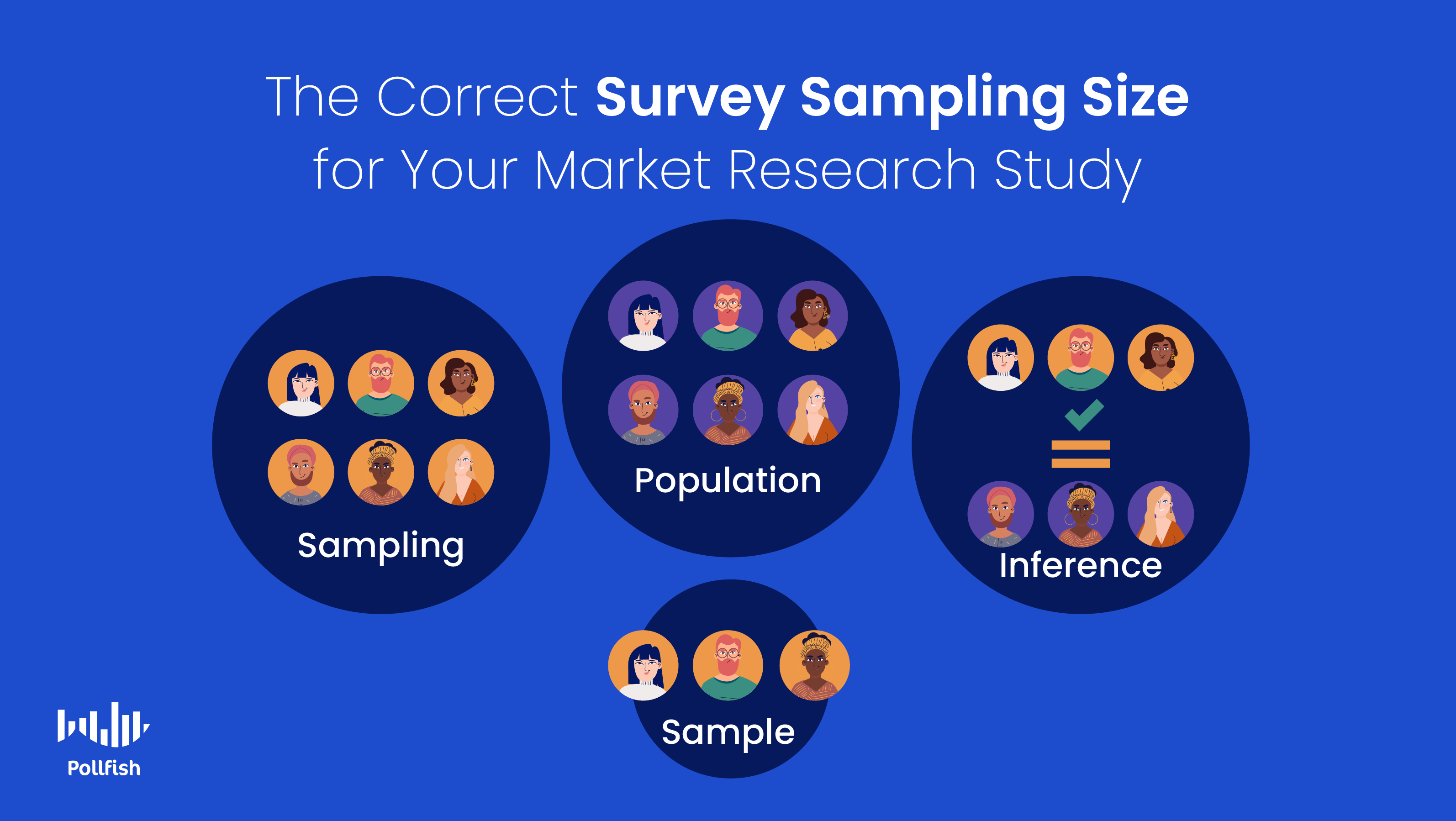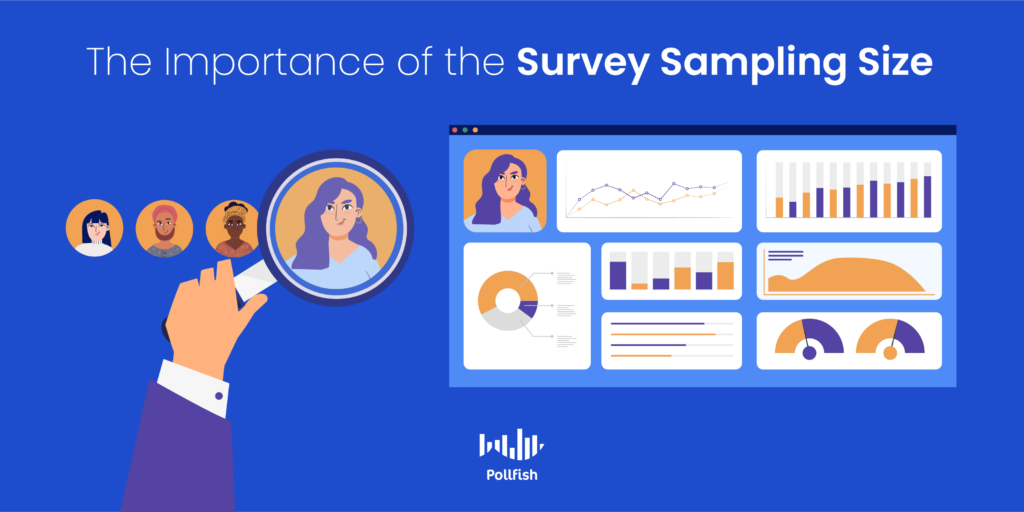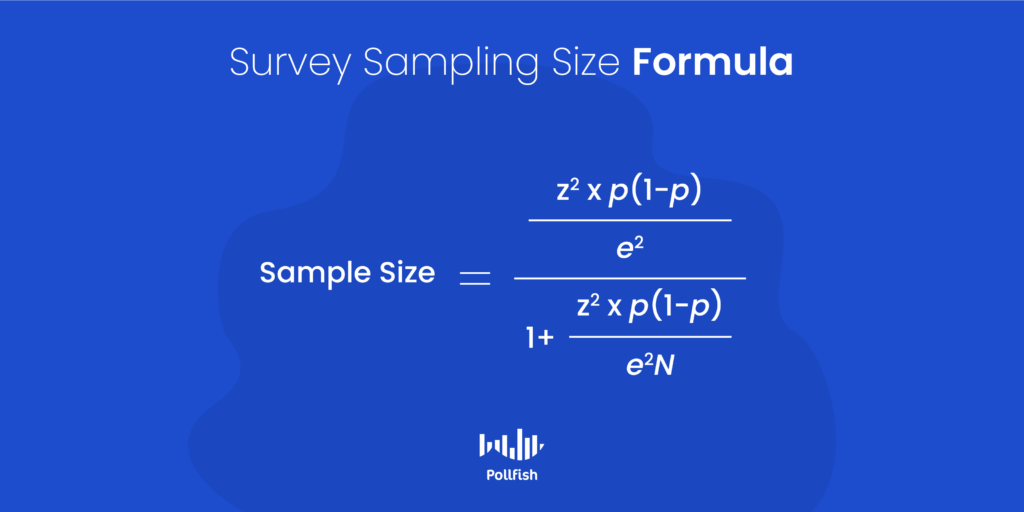Discovering the Correct Survey Sampling Size for Your Market Research Study

Determining the correct survey sampling size is necessary for establishing a statistically valid survey study. A well-founded survey study must be correctly designed and feature accurate conclusions, those that properly reflect the views of its target audience.
Although it is impossible to survey every member of a target population, your survey findings should be an accurate representation of the studied population. That’s where determining the correct survey sampling size comes into play.
However, even with the proper sampling size in tow, all surveys will undergo some degree of the sampling error. This is because surveys don’t extract the thoughts of every member of a population. Therefore, some findings will be inaccurate.
This article explains how to find the correct survey sampling size, its importance and the sampling size in relation to the margin of error.
Understanding the Survey Sampling Size
The survey sampling size refers to the number of respondents that take part in a survey study, which is also called the sampling pool. Used in market research and statistics, this size is usually determined with regards to the estimated size of the entire population under study.
This sampling pool is composed of a random sample of respondents who represent the studied population at large, as opposed to making up the entire population being studied, as it is impossible to survey every single member in a targeted population.
Market researchers need to determine the proper sampling size for all kinds of survey sampling methods, including probability or random sampling and non-probability or non-random sampling.
Aside from being calculated to find the size most appropriate for representing a large population, the survey sampling size is also useful for reducing the four types of sampling errors.
To determine the correct sampling size for your study, you’ll need to calculate it using several variables. (More on this in a later section).
The Importance of the Survey Sampling Size
The size of your sampling pool should never be random or made at a whim. Otherwise, you’re risking the quality and accuracy of your survey study. The survey sampling size is crucial on a number of fronts.
It is critical to market research campaigns, in that the sample size influences two statistical properties: the precision of our estimates and the power of the study to draw conclusions.

The survey study you run will always have some margin of error in the study results. This influences the precision of the survey results and their use to make predictions. Although this error is inevitable, it can be reduced with the correct sample size.
Larger samples are usually associated with a smaller margin of error. This makes sense when you consider the thousands and even millions of consumers that can fit under one segment of a target market, which can be the target audience of a survey campaign. As such, the larger your sample size, the more insights you gain that represent this audience.
However, there is a point when increasing the survey sample size has no impact on the sampling error. There are also plenty of instances when failing to use an appropriate sampling size undermines the entire study.
You should therefore be careful when calculating your survey sampling error, as both a sample size that is too large and too small will have substandard results.
What Happens When a Sample Size is Too Small
When a sample size is too small, its results will be inconclusive and, in many cases, such as in experimental research, unethical. Thus, in these cases, you won’t be able to make accurate predictions or take actions that require testing, as they may be dangerous. For example, you can’t expose humans or lab animals to possible risks associated with research.
Additionally, the data from this kind of sampling size will yield a disproportionate number of respondents with anomalous answers. These will skew the results, so you won’t retrieve an accurate understanding of the entire targeted population.
What Happens When a Sample Size is Too Large
Using a sample size that is too large is wasteful on both time and resources. It relies on more respondents than is necessary to carry out the survey campaign for accurate findings. With surplus data, the study is not representative of its target population.
This kind of sampling size will also incur more expenses to run the study, which could and should have been avoided.
All in all, an appropriate determination of the survey sampling size for a survey study is an essential aspect of the design of this kind of study.
How to Find the Correct Survey Sampling Size
As aforementioned, determining the correct survey sampling size involves using four variables. These are the population size, margin of error or confidence interval and sampling confidence level.
Once you’ve gathered the information you’ll need to determine the value of each, you can then proceed to the survey sampling size formula and simply plug them in.
Population Size
This variable refers to the total number of people in the population that you seek to survey. When dealing with broad populations, this size will likely be an estimate. For example, the population size of New York City is about 8.419 million people. A much smaller population, such as that of employees, is going to be definite.
Margin of Error
Also called the confidence interval, this is a percentage that relays how much you can expect your survey results to reflect the views of the overall population you’re surveying. Market researchers ought to aim for a smaller margin of error, as the smaller it is, the closer you’ll be to the exact answer at a given confidence level.
Essentially, it answers how much error you’ll have, which dictates how far a percentage will stray. For example, if 70% of respondents said yes to a particular question, with a margin of error of +/- 5%, then the correct percentage is straying by 5% points in either direction. As such, the true percentage is between 65 and 75%.
If you need to determine your margin of error, use the Pollfish Margin of Error Calculator.
Sampling Confidence Level
Although it has a similar name to the previous variable, this is a separate input, dealing with how confident you can be that the population would select an answer within a certain range. For example, a 95% confidence level means that you can be 95% sure the results lie between two certain numbers. The three most common confidence intervals are 90% confident, 95% confident, and 99% confident.
Standard Deviation
This variable Is an estimate of how much your responses will vary from each other and from the mean number. It studies how much individual sample data points deviate from the average population.
A low standard deviation shows that all the values will be situated around the mean number. A high standard deviation means the values are spread out on a much wider range and have very small and very large outlying figures.
Use the standard deviation of 0.5 to make sure that your sampling pool is large enough.
The Next Steps
When you have determined the value of each variable, fill them into the calculation in the section below. The following is a breakdown of the variables:
N = population size
E = Margin of error (percentage in decimal form)
Z = z-score
P = standard deviation
The z-score is the number of standard deviations that a given proportion is away from the mean. To find your proper z-score, use the table below as a reference:
| Desired confidence level | Z-score |
| 80% | 1.28 |
| 85% | 1.44 |
| 90% | 1.65 |
| 95% | 1.96 |
| 99% | 2.58 |
How to Calculate the Survey Sampling Size
Now that you understand each variable used to determine your ideal sampling size, use the following formula to calculate the correct survey sampling size for your particular survey study.
The formula is:
Sample Size = (Z² x P (1 – P) / E²) ÷ 1 + ( (Z² x P (1 – P)) / E² N))
Please refer to the following image for a more visual representation:

If you prefer a more efficient way to determine your sampling size, refer to the Pollfish sample size calculator.
Survey Sampling Size Tips
Calculating your sample size can be a complex process for those not familiar with statistical calculations or who don’t perform mathematics in their daily lives. There are a few key considerations that will help you make sense of the confusion.
Firstly, if you want a smaller margin of error, you will need to have a larger sample size given the same population. Next, if you seek a high sampling confidence level, you’ll need a larger sample size.
If your survey sample size becomes too big to handle, you can adjust the results by doing the following:
- decreasing your confidence level
- increasing your margin of error
Doing so will increase the chance for error in your sampling pool. However, it can also significantly decrease the number of responses you’ll need.
Optimizing Your Market Research with the Right Sampling Size
To optimize the findings of your survey study, you’ll need to use the correct survey sampling size. The correct sampling size will solidify the accuracy of your data and posit you as more of an authority figure in any of the six main types of research.
Additionally, it will give you peace of mind that the results you’ve extracted are accurate and can be used to take action, whether it is for a business or a research study in other fields.
In addition to an accurate sampling size, you’ll need a strong online survey platform to carry out all your survey campaigns.
We suggest using a strong online survey platform, one that offers agile market research and engages respondents in their natural digital environments via random device engagement (RDE) sampling. It should also be designed via a mobile-first platform, as mobile devices dominate the digital space.
When market researchers use an online survey platform with these capabilities, they are setting themselves up for success in all their survey campaign needs.
Do you want to distribute your survey? Pollfish offers you access to millions of targeted consumers to get survey responses from $0.95 per complete. Launch your survey today.
